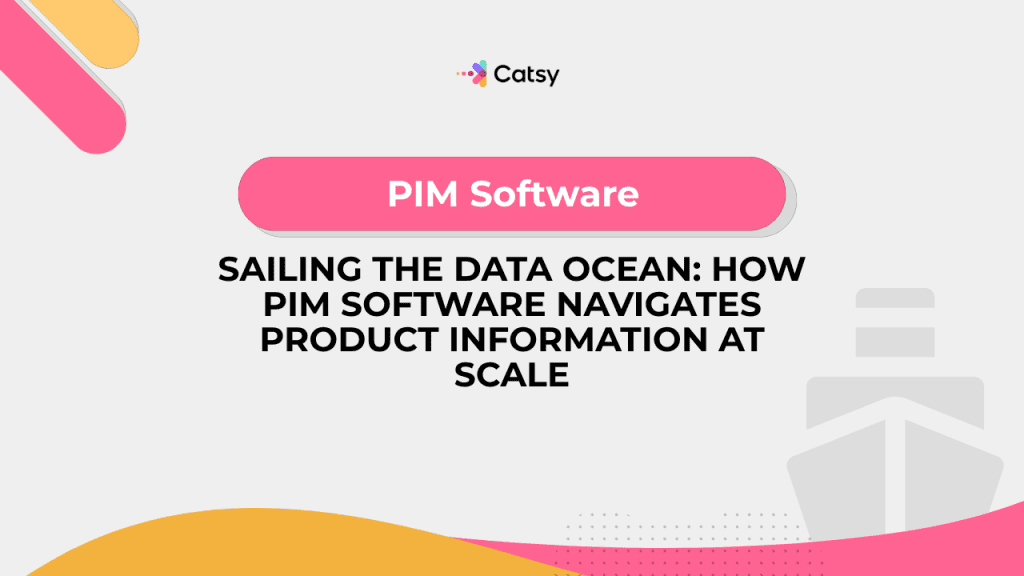Sailing the Data Ocean: How PIM Software Manages Product Data at Scale
Modern commerce is like a vast ocean, and businesses often find themselves navigating larger fleets of product data. What begins as a few hundred SKUs can quickly expand into a full armada of thousands, each requiring precise navigation across multiple channels.

Table of Contents
- Navigating Product Data at Scale: Understanding the Maritime Challenge
- Why Scaling Product Data Management Requires a PIM Lighthouse
- 7 Ways PIM Software Commands Your Data Fleet at Scale
- Navigational Success Stories: Real-World Scaling Voyages
- Choosing Your PIM Vessel: Key Features for Scaling
- Setting Your Course: Implementation Strategies for Scale
- Captain’s Wisdom: Key Takeaways
- Navigating Your Questions: FAQ
What You Will Learn
- How PIM software transforms chaotic product data oceans into well-charted shipping lanes for businesses managing thousands of SKUs
- The critical capabilities that enable PIM systems to serve as your North Star when scaling from hundreds to millions of products
- Proven strategies for maintaining data quality and consistency as your product fleet expands across global markets
In this Article
Navigating Product Data at Scale: Understanding the Maritime Challenge
Modern commerce is like a vast ocean, and businesses often find themselves navigating larger fleets of product data. What begins as a few hundred SKUs can quickly expand into a full armada of thousands, each requiring precise navigation across multiple channels.
Like ancient mariners who evolved from coastal sailing to transoceanic voyages, today’s businesses must evolve their data management capabilities to handle scale.
The Rising Tide of Product Complexity
Managing product data at scale isn’t just about handling more items, it’s about handling their complexity. Attributes, relationships, compliance requirements… These are all critical pieces of information to manage.
Consider a company expanding from 1,000 to 100,000 products. They’re not just multiplying their cargo exponentially, they’re also creating new relationships and variant combinations. Channel-specific requirements are essential to navigate, too.
Each product becomes a vessel in your fleet, requiring its own manifest, maintenance log, and navigation plan.
When Manual Navigation Fails
Traditional spreadsheet-based product management is like a wobbly rowboat. It gets the job done, but teams may find themselves drowning in rough waters. Manual updates impact data quality, increasing error rates. And if your teams are manually entering information it will stretch out your time-to-market.
It’s a recipe for a shipwreck.
Why Scaling Product Data Management Requires a PIM Lighthouse
The Beacon of Centralization in Stormy Seas
As your product fleet grows, the need for a centralized command center becomes critical.
As your product fleet grows, so does your need for a centralized data center. Product Information Management (PIM) software serves as your lighthouse; it’s a steady, reliable beacon that guides your data vessels.
Unlike scattered spreadsheets drifting like lifeboats, a PIM system provides a fortified harbor where all product information can anchor securely.
Navigating the Multiplication Effect
When you’re managing data at scale, small inefficiencies can stir up major storms. Even a 1 percent error rate on 100 products can create a massive crisis when you scale to 100,000 products.
PIM software acts as your navigation system, maintaining accuracy even as your armada grows. PIM transforms what would be an impossible manual voyage into a manageable journey with clear charts and reliable instruments.
The Cost of Sailing Without Proper Equipment
According to Forrester research, companies managing large product catalogs without PIM systems spend up to 75 percent more time on data management tasks compared to those with proper solutions.
That’s like trying to cross the Pacific with oars instead of sails. It’s technically possible, but it’s not recommended!
The hidden costs of poor data quality at scale may include lost sales, delayed launches, and the erosion of consumer trust.
Meeting Modern Commerce Currents
Today’s e-commerce demands aren’t about volume, but velocity. Customers expect real-time accuracy no matter where they find your products, from your own website to your marketplace outposts.
Search algorithms favor merchants who can maintain rich, accurate data across each of their platforms. Without PIM software, navigating these demands becomes near to impossible.
Make Catsy DAM and PIM Software an Extension of Your Team
Book a Free Demo7 Ways PIM Software Commands Your Data Fleet at Scale
- Automated Data Validation: Your First Mate for Quality Control
As your product armada grows, manually checking quality can be likened to checking each plank of your ship. PIM software can help!
Your PIM can deploy automated validation rules that will check each piece of data for you. These systems can validate millions of attributes per minute, catching errors that would certainly slip by your human crew.
Advanced PIM platforms use AI-powered validation to identify anomalies across huge data sets. Automated checks for pricing errors, missing attributes, and implausible specs keep your data fresh, accurate, and customer-ready.
- Bulk Operations: Commanding Entire Fleets with Single Orders
Imagine trying to change course for 10,000 ships by visiting each captain individually
Imagine you’re trying to change 10,000 ships’ courses, but you have to visit each captain individually to do so. What a mess! But that’s what large catalogs can feel like without PIM.
PIM systems provide bulk operation capabilities that let you command your whole “fleet” with single actions.
Need to update pricing for a category? Adjust specifications for a product line? Add new attributes across thousands of items? PIM software can do this in minutes, not months.
These bulk capabilities extend beyond simple updates. You can mass-enrich products with AI-generated descriptions, apply complex pricing rules across regions, or reorganize entire category structures. It’s like having signal flags that instantly communicate orders to your entire armada, ensuring coordinated movement at scale.
- Hierarchical Data Management: Organizing Your Naval Formations
At scale, flat data structures will collapse. PIM software provides sophisticated hierarchical management that prevents this. Parent-child relationships, category trees, and attribute inheritance create order from chaos. Your data can be as navigable as well-charted waters.
A hierarchical approach will enable you to efficiently manage your data through inheritance. That means you’ll set attributes at the category level and your PIM will automatically assign those attributes to their child products.
- Workflow Automation: Your Trade Wind Advantage
Manual approval processes at scale are like trying to personally inspect every barrel of cargo. It’s super-slow and quite error-prone. PIM workflow automation creates tailwinds that will speed your products through the data pipeline.
Automated workflows can be used for translation, quality checks, approval requests, and so much more… then push that data to your channels without manual processes.
These workflows scale linearly with your catalog size. Whether you’re processing 100 or 100,000 products, automated workflows maintain consistent velocity. Use powerful automation for repetitive tasks like seasonal updates, regulatory compliance checks, or multi-channel syndication.
- Integration Orchestration: Coordinating Your Port Network
When you scale, your PIM system must coordinate with an entire ecosystem of ports and harbors. These may include ERPs, e-commerce platforms, marketplaces, and internal processes.
A modern PIM provides sophisticated integration capabilities that will maintain your data sync – no matter how many platforms you utilize. APIs and webhooks create real-time data streams, ensuring that your product information reaches every destination port accurately.
This becomes critical as you scale. Think about it: a single update may need to flow to 20 different systems, all with their own requirements.
PIM software handles this complexity through integration mapping, transformation rules, and queue management. It’s like having a harbor master at every port to ensure smooth docking and cargo transfer… regardless of local requirements.
- Performance Optimization: Maintaining Speed in Heavy Seas
Traditional databases can sink under the weight of huge catalogs, and query times can stretch out longer than a sea voyage. Enterprise PIM systems use advanced architectures to maintain lightning-fast performance.
This performance also impacts your customers. Advanced filtering, faceted search, and lazy loading ensure that your customers – and your teams – can navigate large catalogs as easily as small ones.
Whether searching for a specific SKU in a million-item catalog or bulk-updating thousands of products, the system responds with the speed of favorable headwinds.
- Scalable Governance: Maritime Law for Your Data Fleet
As you grow your catalog, it can become more challenging to maintain consistency. PIM software can help! It provides scalable governance frameworks – much like maritime law – for your data. Role-based access and audit trails ensure that your data is only being accessed and changed by those with proper permissions. Version control allows you to revert to a previous state.
These governance capabilities scale automatically with your catalog. Whether you’re managing 10 users or 1,000, the same governance framework maintains order. Automated compliance checks ensure that each of your products meet regulatory requirements across different markets.
Navigational Success Stories: Real-World Scaling Voyages
The Manufacturing Galleon: 50,000 to 500,000 Products
A global manufacturing conglomerate faced rapid acquisition growth that expanded their catalog from 50,000 to more than 500,000 SKUs across 15 brands. Their spreadsheet armada was creaking under the weight of their data, with inconsistencies in data causing customer dissatisfaction as well as compliance violations.
By implementing a cloud-based PIM system, they transformed that fleet into a well-organized navy. Automated data validation decreased error rates by 94 percent. Bulk enrichment enabled the addition of marketing content to 300,000 products in only six weeks. Most importantly, their time-to-market decreased by 60 percent. This allowed them to seize on new opportunities.
The Retail Armada: Conquering Omnichannel Scale
A major retailer was managing 2 million SKUs across over 50 catalogs, and struggled with the complexity of omnichannel distribution. Each channel required different data formats and attributes. Legacy systems created data silos that made consistency impossible to scale.
Implementing a PIM system created a unified command center for all of their teams. Now, integration orchestration pushes updates to more than thirty channels simultaneously! Workflow automation reduced manual touchpoints by 80 percent, and hierarchical categories made navigation easy.
The result? A 40 percent increase in online conversion rates and a 50 percent reduction in product data management expenses.
The Marketplace Explorer: From Startup to Scale
A marketplace platform discovered that success comes with challenges! As they grew from 10,000 to one million SKUs in just 18 months, they found that their data management was capsizing. Challenges included vendor onboarding bottlenecks and quality control struggles.
By implementing a PIM system, the platform transformed their trajectory. Automated vendor onboarding can now process 1,000 new suppliers monthly. AI-powered data standardization maintains data consistency. Real-time synchronization ensures that consumers see more accurate information. Finally, they’ve maintained sub-second search performance despite their 100x growth.
Choosing Your PIM Vessel: Key Features for Scaling
Hull Strength: Core Architecture Considerations
Not all PIM vessels are built for ocean crossings. Look at the core architecture. Cloud-native solutions offer scalability to expand automatically with your needs. Look for distributed architectures that prevent failure in a single point. And ensure that the system can handle your current – and projected – growth.
There are a few key architectural features to look for. Elastic computing resources are one – these can expand during peak loads. Distributed caching enhances your global performance. And API-first design allows for scalability.
These features determine whether your PIM vessel can weather the storms of growth.
Navigation Instruments: Essential Scaling Features
Your PIM system needs sophisticated navigational instruments. Advanced search capabilities are critical with large catalogs, so look for AI-powered search, faceted filtering, and saved search options. Bulk operations should be able to handle thousands of items efficiently.
Data quality features gain importance at scale, too. Automated validation, duplicate detection, completeness scoring, and anomaly detection are all important. These help you maintain your accuracy across large catalogs. Finally, look for a system that supports real-time synchronization with all of your systems.
Crew Quarters: User Experience at Scale
Consider your crew. Your teams must be able to use your PIM system to manage millions of products. Look for intuitive user interfaces that won’t degrade as you grow your catalog. Role-based dashboards and mobile accessibility are also critical considerations.
Performance optimization features like lazy loading, smart caching, and asynchronous processing ensure that your system will remain responsive. Collaboration tools are essential to scaling your business, and the best PIMs make managing a million products just as simple as managing a thousand.
Setting Your Course: Implementation Strategies for Scale
Charting Your Growth Trajectory
Before setting sail, map your growth journey. Project your catalog growth over 3-5 years, considering organic expansion, acquisitions, and new market entries. Then, identify scaling triggers (points where your current approach will fail).
Don’t just consider the products you’ll add, but also consider the growth in complexity. Will you require new attribute sets? Will you add channels with unique requirements? Enter markets with specific compliance needs? Your PIM should support this growth.
Phased Fleet Deployment
Instead of attempting to migrate your entire armada at once, it may be best to use a phased deployment. Begin with just one category or brand to establish your processes and train your crews. Then, expand gradually, learning as you go. This reduces risk and builds confidence.
You can create migration waves based on priority and complexity. Your higher value products might sail first, followed by your long-tail catalog items. Each wave should demonstrate tangible benefits that will build momentum for your overhaul.
Building Your Data Navy
Scaling successfully requires the right crew organization. You’ll need to establish clear roles. Data admirals will set strategy, fleet commanders will manage categories, and sailors will handle the day to day operations. Invest in training programs for your crew, and document your processes for future growth.
Don’t forget: governance structures become critical at scale. Establish data quality standards, workflow protocols, and integration patterns early. Regular audits and optimization reviews ensure your processes scale efficiently with your products.
Captain's Wisdom: Key Takeaways
- Scale demands automation: Manual processes may work for hundreds of products, but they create catastrophic bottlenecks at thousands. PIM software provides the automation needed to maintain quality and velocity at scale.
- Architecture determines destiny: Choose PIM systems built for your destination. Cloud-native, API-first architectures provide the elasticity needed for growth.
- Governance scales exponentially: Data quality issues will multiply with catalog size. Establish robust governance frameworks early on to prevent small problems from becoming fleet-wide crises.
- Integration is your trade network: At scale, your PIM system should orchestrate complex ecosystems. Sophisticated integration capabilities determine how efficiently your data reaches each market.
- Performance powers possibility: Sub-second response times aren’t luxury when you scale – they’re mandatory. Ensure that your PIM vessel can maintain speed even in the heaviest data seas.
- Phased implementation reduces risk: Navigate growth through planned waypoints rather than attempting impossible leaps. Each phase should deliver value while building toward your ultimate destination.
Want more tips, tutorials, and insights on product content and e-commerce operations?
Stay connected. We post regularly to help brands like yours scale smarter.
Are You Ready To streamline your product content management?

Frequently Asked Questions
Most businesses hit scaling challenges at around 5,000-10,000 SKUs, although the complexity of your products matters just as much as your volume. If you manage multiple channels, variants, or if you’re spending more time on data management than actual strategy, you’ve probably outgrown your manual systems.
Warning signs can include an increase in error rates, a slowed time-to-market, and team frustration with data tasks.
Modern PIM systems use sophisticated architectures designed for scale.
Distributed databases spread the load across multiple servers. Intelligent caching keeps frequently accessed data readily available. Search indices enable near-instant queries across vast catalogs. And lazy loading and pagination prevent interface overload.
The result is consistent performance whether you’re managing thousands or millions of products.
Organizations typically see a 40-60 percent reduction in data management time, a 30-50 percent faster time-to-market for new products, and an 80-90 percent reduction in data error rates.
For a company managing 100,000+ SKUs, this often translates to millions in annual savings from efficiency gains alone. Add in the revenue benefits from faster market entry, improved data quality, and better customer experiences, and ROI often exceeds 300 percent within 18-24 months.
Yep, enterprise PIM systems excel at managing complex relationships… even with massive catalogs. They support sophisticated parent-child relationships, cross-sells and upsells, and relationships between variants. Graph database tech can enable lightning-fast queries across your catalog.
Whether you’re tracking component dependencies or style variants, a PIM system can maintain these relationships accurately… at any scale.
Implementation timelines will vary based on your catalog complexity and integration requirements. A phased approach typically shows initial pilot in 2 to 3 months and a core catalog migration in 12 to 18 months.
That said, you don’t need to wait for full deployment to see benefits. Most organizations achieve positive ROI from their pilot phase through improved efficiency in their targeted categories.
Professional PIM implementations include comprehensive data migration strategies. Your existing data is mapped, cleansed, and transformed to match your PIM structures. Most systems support parallel running, allowing you to maintain current operations while building your new environment.
Think of it as transferring cargo to a new vessel while keeping your current ship operational, ensuring no disruption to your business operations.
PIM systems deploy multiple defensive layers, including automated validation rules to catch errors at entry, completeness scoring to ensure that all required data is present, duplicate detection to prevent redundancy, and anomaly detection to flag outliers.
Machine learning capabilities can identify patterns and suggest corrections across large datasets. And regular quality audits and scorecards maintain standards even as catalogs grow exponentially.
Modern PIM systems are built to scale to a global level. They support unlimited languages and locales, manage region-specific attributes and compliance requirements, and enable local autonomy within global governance frameworks.
Multi-tenant architectures allow different markets to operate independently while you maintain central control. Currency management, unit conversions, and tax handling adapt automatically to local requirements.
At scale, look for PIM systems offering REST/GraphQL APIs for custom integrations, pre-built connectors for major platforms, and webhook support for real-time events. Bulk data import and export capabilities and message queue integration for high-volume processing are also important.
Your system should handle thousands of concurrent API calls, and should support both synchronous and asynchronous patterns. Integration monitoring and error handling are critical for maintaining ecosystem health.
Success requires both tools and training. Establish clear roles and responsibilities as you scale, like data governance teams, category managers, and content specialists.
Invest in comprehensive training… not just on PIM tools, but on data management best practices! Create documentation and playbooks that standardize your processes and make them accessible to future teams. Remember, even the best ship requires a skilled crew to reach its destination.
Subscribe For More Content
Sign up for monthly tips on how to drive revenue with product content.




